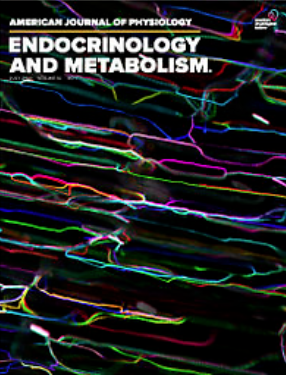Metabolic outcomes in obese mice undergoing one-anastomosis gastric bypass (OAGB) with a long or a short biliopancreatic limb
IF 3.1
2区 医学
Q1 ENDOCRINOLOGY & METABOLISM
American journal of physiology. Endocrinology and metabolism
Pub Date : 2024-04-17
DOI:10.1152/ajpendo.00327.2023
引用次数: 0
Abstract
One-anastomosis gastric bypass (OAGB) has gained importance as a safe and effective operation to treat morbid obesity. It is not known whether a long biliopancreatic limb (BPL) in OAGB surgery compared to a short BPL results in beneficial metabolic outcomes. 5-week-old male C57BL/6J mice fed a high-fat diet for 8 weeks underwent OAGB surgery with defined short and long BPL lengths, or sham surgery combined with caloric restriction. Weight loss, glucose tolerance, obesity-related comorbidities, endocrine effects, gut microbiota and bile acids were assessed. Total weight loss was independent of the length of the BPL after OAGB surgery. However, a long BPL was associated with lower glucose-stimulated insulin on day 14, and an improved glucose tolerance on day 35 after surgery. A long BPL resulted in reduced total cholesterol. There were no differences in the resolution of metabolic dysfunction-associated steatotic liver disease and adipose tissue inflammation. Tendencies of an attenuated hypothalamic-pituitary-adrenal axis and aldosterone were present in the long BPL group. In OAGB-operated mice, we found an increase in primary conjugated bile acids (pronounced in long BPL) along with a loss in bacterial Desulfovibrionaceae and Erysipelotrichaceae and simultaneous increase in Akkermansiaceae, Sutterellaceae and Enterobacteriaceae. In sum, OAGB surgery with a long compared to a short BPL led to similar weight loss, but improved glucose metabolism, lipid and endocrine outcomes in obese mice, potentially mediated through changes in gut microbiota and related bile acids. Tailoring the BPL length in humans might help to optimize metabolic outcomes after bariatric surgery.采用长或短胆管胰管肢体的单吻合胃旁路术(OAGB)肥胖小鼠的代谢结果
单吻合胃旁路术(OAGB)作为治疗病态肥胖症的一种安全有效的手术,其重要性日益凸显。目前尚不清楚在单吻合胃旁路手术中长胆管胰管肢体(BPL)与短胆管胰管肢体(BPL)相比是否会带来有益的代谢结果。以高脂肪饮食喂养 8 周的 5 周大雄性 C57BL/6J 小鼠接受了确定长短 BPL 长度的 OAGB 手术,或结合热量限制的假手术。对体重减轻、葡萄糖耐量、肥胖相关并发症、内分泌影响、肠道微生物群和胆汁酸进行了评估。OAGB手术后,总减重与BPL的长度无关。然而,BPL较长与术后第14天葡萄糖刺激胰岛素较低和术后第35天葡萄糖耐量改善有关。BPL 长度越长,总胆固醇越低。在解决代谢功能障碍相关的脂肪性肝病和脂肪组织炎症方面没有差异。长BPL组出现了下丘脑-垂体-肾上腺轴和醛固酮减弱的趋势。在接受 OAGB 手术的小鼠中,我们发现初级共轭胆汁酸增加(长 BPL 组明显增加),同时脱硫杆菌科和 Erysipelotrichaceae 细菌减少,而 Akkermansiaceae、Sutterellaceae 和 Enterobacteriaceae 同时增加。总之,与短BPL相比,长BPL的OAGB手术导致肥胖小鼠体重减轻的效果相似,但改善了糖代谢、血脂和内分泌结果,这可能是通过肠道微生物群和相关胆汁酸的变化介导的。在人体中调整BPL的长度可能有助于优化减肥手术后的代谢结果。
本文章由计算机程序翻译,如有差异,请以英文原文为准。
求助全文
约1分钟内获得全文
求助全文
来源期刊
CiteScore
9.80
自引率
0.00%
发文量
98
审稿时长
1 months
期刊介绍:
The American Journal of Physiology-Endocrinology and Metabolism publishes original, mechanistic studies on the physiology of endocrine and metabolic systems. Physiological, cellular, and molecular studies in whole animals or humans will be considered. Specific themes include, but are not limited to, mechanisms of hormone and growth factor action; hormonal and nutritional regulation of metabolism, inflammation, microbiome and energy balance; integrative organ cross talk; paracrine and autocrine control of endocrine cells; function and activation of hormone receptors; endocrine or metabolic control of channels, transporters, and membrane function; temporal analysis of hormone secretion and metabolism; and mathematical/kinetic modeling of metabolism. Novel molecular, immunological, or biophysical studies of hormone action are also welcome.

 求助内容:
求助内容: 应助结果提醒方式:
应助结果提醒方式:


